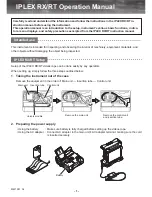
E-2
Return to
2600S-901-01 Rev. C / January 2008
Appendix E: Speed Specification Test Conditions
Series 2600 System SourceMeter® Instruments Reference Manual
Introduction
The purpose of this Keithley Instruments
appendix is to provide a general procedure for obtaining
speed results similar to those listed in the Series 2600 System SourceMeter
®
Specifications in
. Tests were performed using Visual Basic and VISA calls.
Test system used
PC Hardware:
Pentium
®
4 2.4GHz, 512MB RAM, National Instruments
PCI-GPIB
Series 2600 Unit:
Model 2602 (test runs on smuA only)
Software:
Microsoft
®
Windows
®
2000, Microsoft
®
Visual Basic
®
6.0,
VISA version 3.1
Drivers
:
(PCI-GPIB) NI-488.2 version 2.2
Overview
Speed tests are separated into four categories: Sweep Operation Rates, Single Operation Rates,
Function/Range Change Rates, and Command Processing. More detail on the tests is provided in
the following paragraphs.
Sweep Operation Rate tests use a script to set up the instrument to record a large number of
measurements. The script sends a single print command at the end of the test to signal the test
program when it is done. Single Operation Rate tests also use a script to send out measure
commands. Samples are received one at a time from the test program instead of collected inside a
script. Function/Range Change Rate tests measure the time it takes to change either a function or
range. Command Processing tests measure the time it takes to receive and process a command.
Sweep Operation Rates
The procedure for the Sweep Operation Rates test is listed below:
1. Short pins 1 and 2 of the digital I/O connector and power on the unit. Tests involving the
digital I/O include time to receive a trigger from pin 2 to pin 1.
2. A script puts the Series 2600 into a known test state, maximizing performance of the
instrument. It is sent to the instrument but not yet executed. A large number of samples are
taken once the script is run. This is necessary to minimize error due to resolution of the
Timer() function in Visual Basic.
3. The unit is placed in sync with the test program to guarantee that the timing results will not
include execution time from previous commands. A simple way to sync the unit is to issue a
print command.
Private Sub Sync_Unit()
ReceiveBuffer = ""
TransmitBuffer = "print('done')" & CRLF
VisaStatus = viWrite(VisaSession, TransmitBuffer, Len(TransmitBuffer),
ReturnCount)
VisaStatus = viRead(VisaSession, ReceiveBuffer, MAX_BUFFER, Return-
Count)
End Sub
4. A snapshot of the timer is taken, after which the script mentioned in step 2 is sent to the unit.
The test program collects all data returned from the instrument. In the case of “X to memory”
tests, a single result is sent to the test program notifying that the test is done. In the case of
“X to gpib” speed tests, the program receives all measured data. Finally, another snapshot
of the timer is taken. The difference between the start and end time is the speed result.
















































